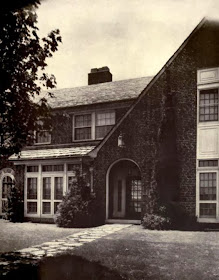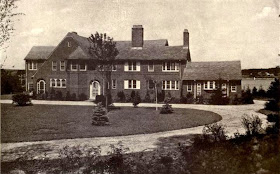WM. H. Gompert, Architect
LEWIS & VALENTINE, Landscape Architects
 |
| The property included a wide sloping lawn leading down to the beach with a pier, bathhouse and large stone boathouse. Designed in 1921. |
The name “Many Gables” is derived from the ensemble of its many gables which exceed in number the house made famous by Hawthorne.
 |
| HOUSE OF EUGENE KIENLE, ESQ., GREAT NECK. L. I., N. Y. WM. H. COMPERT. ARCHITECT |
The walls are constructed of red clinker bricks carefully selected so that while the predominating color is red, the surfaces have been mottled with dark blue, purple and black clinkers featured in the laying of the masonry. The appearance of the brick work has been further enhanced by the light cream colored bed and cross joints which are arranged in such a manner as to give the effect of an underlying plaid weaving, in wall surfaces.
 |
| HOUSE OF EUGENE KIENLE, ESQ., GREAT NECK. L. I., N. Y. WM. H. COMPERT. ARCHITECT |
The window frames and casings are painted a strong cream color. The leaders, barge boards, eaves and flashings are of copper, and have been treated so that they have a soft vert antique tone.
The roofs are covered with a heavy Tudor slate 1 1/4 in thickness at the eaves and laid 10" to the weather and graduated in thickness to 1/2" at the ridges where the surfaces to the weather had been diminished to 3".
The slate is of variegated colors consisting of soft tones of purple, green, grey and blues.
 |
| HOUSE OF EUGENE KIENLE, ESQ., GREAT NECK. L. I., N. Y. WM. H. COMPERT. ARCHITECT |
The hips of all roofs have been built with a slight concave curvature and all valleys formed by the intersection of the various surfaces of the roof have been rounded and covered with slate.
The chimneys are built of the same kind of brick as the walls of the house and are topped with buff colored terra cotta chimney pots.
 |
| FIRST FLOOR PLAN HOUSE OF EUGENE KIENLE, ESQ., GREAT NECK. L. I., N. Y. WM. H. COMPERT. ARCHITECT |
The floors of the entrance loggias are paved with a biscuit color faience tile with black and pewter colored faience tile borders.
The floors of the entrance loggias are paved are paved with heather brown tiles with black faience borders.
The floors throughout the principal rooms are of oak and stained and treated in imitation of teak wood. The trim throughout is of simple design, painted, enameled and glazed to match the wood work of the respective rooms.
The study is reached by rising two steps from the entrance hall and crossing the broad platform at the foot of the main stairs and has been decorated and furnished in Chinese effects.
The Living Room is carried out in early Italian Renaissance style as are also the furnishings all of which take their note from the antique imported Carrara marble mantel, whereas the Dining Room is of Jacobian style with the furniture of the Cromwellian period. The chambers are decorated in the Georgian, Queen Anne and Colonial periods.
 |
| SECOND FLOOR PLAN HOUSE OF EUGENE KIENLE, ESQ., GREAT NECK. L. I., N. Y. WM. H. COMPERT. ARCHITECT |
The three principal chambers on the 2nd story each have a large sleeping porch adjoining, which have been carefully concealed in the exterior design so as not to present a detrimental motif as is frequently the case with sleeping porches.
The bath rooms have been paved with white herringbone tiling with black faience borders and the walls to a height of 7'0" have been tiled with white tile with a black glazed border near the top.
This house is heated by a vacuum steam heating system, with thermostatic control.
 |
| GARAGE OF EUGENE KIENLE, ESQ., GREAT NECK. L. I., N. Y. WM. H. COMPERT. ARCHITECT |
Eugene Kienle was founder and president of Kienle & Co., a manufacturer of lithographic and printing inks, based out of Brooklyn, New York. wikimapia location. BING. Click HERE to see a brochure from when "Many Gables" was for sale.












